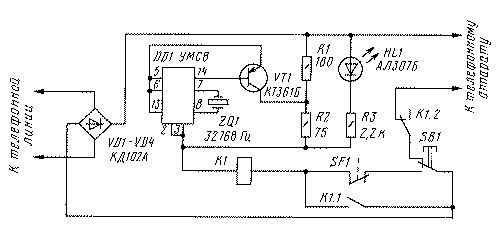The proposed device performs the function of retaining a telephone line ("HOLD") that allows during a call, hang up on the lever and move to parallel telephone.
The device does not overload the telephone line (TL) and does not create interference in it. While operating the caller hears music on hold.
Diagram of the device hold the telephone line shown in the figure. Rectifier bridge diodes VD1-VD4 provides the desired polarity of the supply device regardless of the polarity of connection it to TL. Switch SF1 is connected with the lever telephone (TP) and closes when going off-hook (i.e. locks the button while on-SB1 the tube). If during a call you must go to parallel THE one you need short press the SB1. This triggers the relay K1 are closed contacts K1.1, and the contacts K1.2 open), TL connects equivalent load (chain R1R2K1) and disabled THE one with which this conversation was held. Now you can put the phone on the receiver and switch to parallel.

The voltage drop across the dummy load is 17 Q. When you pick up the handset to parallel THE voltage in the TL drops to 10 V, the relay K1 is turned off and the dummy load is disconnected from TL.
Transistor VT1 must have a transmission coefficient not less than 100, the amplitude of the AC voltage audio frequency, issued in TL, up to 40 mV. As a music synthesizer (DD1) used chip UMS in which the "protection" of two melodies and the alarm signal. Therefore, pin 6 ("select ringtone") is connected to the pin 5. In this case plays the first melody, and then second indefinitely.
As SF1 can be used the microswitch MP or reed switch, controlled by a magnet (magnet must be glued to the lever). Button SB1 - KM1.1, the led HL1 - any of a series AL307. Diodes VD1-VD4 - all allowing for reverse voltage not less than 200 V. Relay K1 - RES-47 (passport RF4.500.409, RF4.500.431 or RF4.500.432).
The device is mounted Assembly and in the establishment does not need.
Applying the resistor R1 resistance 270...390 Ohm, you can increase the voltage drop across the load equivalent to 20...25 In that will allow you to use that ONE when you pick up the handset in which the voltage TL is 15...20 V. the Resistor R3 in this case apply resistance 3...3.3 kω. The voltage drop across the resistor R2 should not exceed 3, otherwise, it will be necessary to reduce the resistance of the resistor R2.
Author: Dmitry Aboutcom; Publication: N. Bolshakov, rf.atnn.ru






